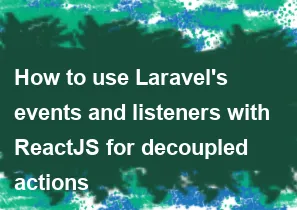How to use Laravel's events and listeners with ReactJS for decoupled actions

Laravel's events and listeners are typically used on the server-side to handle decoupled actions. However, since ReactJS is a front-end library, it doesn't directly interact with Laravel events and listeners. Instead, you can use a combination of Laravel events, listeners, and a communication mechanism like websockets or AJAX to notify the ReactJS application of events on the server side.
Here's a general approach you can follow:
Define Laravel Events and Listeners:
Create an event class (e.g.,
MyEvent) in Laravel.phpphp artisan make:event MyEventModify the event class to provide necessary information to the listener.
php// app/Events/MyEvent.php class MyEvent implements ShouldBroadcast { public $data; public function __construct($data) { $this->data = $data; } public function broadcastOn() { return new Channel('my-channel'); } }Create a listener for the event.
phpphp artisan make:listener MyListener --event=MyEventModify the listener to handle the event.
php// app/Listeners/MyListener.php class MyListener { public function handle(MyEvent $event) { // Handle the event and perform necessary actions. } }
Set up Broadcasting and Websockets (Optional):
Laravel provides support for broadcasting events over websockets. You can use a package like Laravel Echo and Pusher for this purpose.
Configure broadcasting in Laravel (update
.envfile).envBROADCAST_DRIVER=pusherInstall the necessary packages.
bashcomposer require pusher/pusher-php-server npm install --save laravel-echo pusher-jsConfigure Laravel Echo in your ReactJS application.
js// resources/js/bootstrap.js import Echo from "laravel-echo"; window.Echo = new Echo({ broadcaster: 'pusher', key: process.env.MIX_PUSHER_APP_KEY, cluster: process.env.MIX_PUSHER_APP_CLUSTER, encrypted: true, });
Broadcast the Event:
In your Laravel application, broadcast the event when the desired action occurs.
phpevent(new MyEvent($data));
Listen to the Event in ReactJS:
Use Laravel Echo or any other websocket library to listen for events in your ReactJS application.
js// Example using Laravel Echo import Echo from "laravel-echo"; const echo = new Echo({ broadcaster: 'pusher', key: process.env.MIX_PUSHER_APP_KEY, cluster: process.env.MIX_PUSHER_APP_CLUSTER, encrypted: true, }); echo.channel('my-channel').listen('MyEvent', (event) => { // Handle the event in your ReactJS component. console.log(event); });Make sure your ReactJS application is configured to listen for events and update the UI accordingly.
This approach allows you to decouple the back-end (Laravel) from the front-end (ReactJS) using events and listeners, with the option of using websockets for real-time communication. If you don't need real-time updates, you can also use AJAX to periodically check for updates from the server.
-
Popular Post
- How to optimize for Google's About This Result feature for local businesses
- How to implement multi-language support in an Express.js application
- How to handle and optimize for changes in mobile search behavior
- How to handle CORS in a Node.js application
- How to use Vue.js with a UI framework (e.g., Vuetify, Element UI)
- How to configure Laravel Telescope for monitoring and profiling API requests
- How to create a command-line tool using the Commander.js library in Node.js
- How to implement code splitting in a React.js application
- How to use the AWS SDK for Node.js to interact with various AWS services
- How to use the Node.js Stream API for efficient data processing
- How to implement a cookie parser middleware in Node.js
- How to implement WebSockets for real-time communication in React
-
Latest Post
- How to implement a dynamic form with dynamic field styling based on user input in Next.js
- How to create a custom hook for handling user interactions with the browser's device motion in Next.js
- How to create a custom hook for handling user interactions with the browser's battery status in Next.js
- How to implement a dynamic form with dynamic field visibility based on user input in Next.js
- How to implement a dynamic form with real-time collaboration features in Next.js
- How to create a custom hook for handling user interactions with the browser's media devices in Next.js
- How to use the useSWRInfinite hook for paginating data with a custom loading indicator in Next.js
- How to create a custom hook for handling user interactions with the browser's network status in Next.js
- How to create a custom hook for handling user interactions with the browser's location in Next.js
- How to implement a dynamic form with multi-language support in Next.js
- How to create a custom hook for handling user interactions with the browser's ambient light sensor in Next.js
- How to use the useHover hook for creating interactive image zoom effects in Next.js